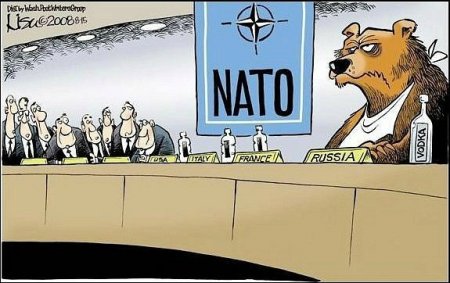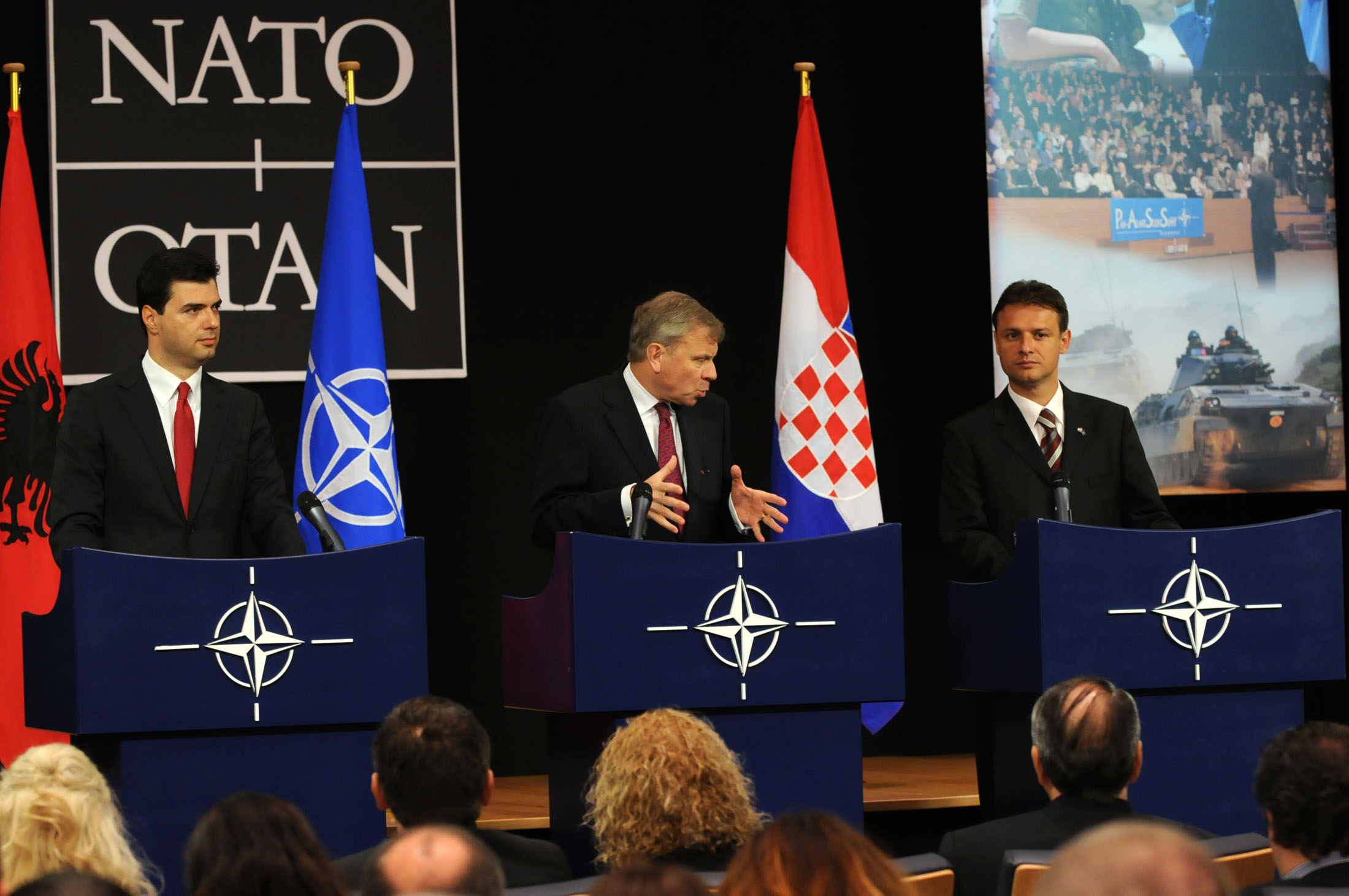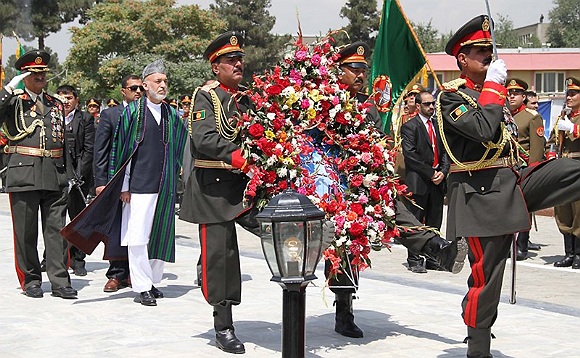NATO foreign ministers’ decision to deploy American, German and Dutch Patriot surface-to-air interceptors to bolster Turkey’s air defences in response to concerns about Syrian missiles takes place against a complex strategic background for the Alliance and its approach to the missile threat. Indeed, NATO’s adoption of territorial ballistic missile defence (BMD) will be a significant test of the notion of the indivisibility of the Alliance. In the absence of a monolithic external threat to the Euro-Atlantic area, the development of a common BMD capability poses dilemmas for NATO solidarity and cooperation.
[captionpix align=”left” theme=”elegant” width=”300″ imgsrc=”http://natoassociation.ca/wp-content/uploads/2013/05/d1.static.dvidshub.net-media-thumbs-photos-1205-584090-300x450_q75.jpg” captiontext=”The NATO Ballistic Missile Defence display at the Chicago Summit.”]
Missile defence tous azimuts?
During the Cold War the deployment of missile systems on member countries’ territory was directly linked to the strategic balance in Central Europe. The purpose of such deployments was to counter the quantitatively superior conventional military forces of the Warsaw Pact or sophisticated missile systems such as the Soviet intermediate-range SS-20. Political differences about how to manage East-West relations were not uncommon, but for the most part decision-makers in national capitals shared Alliance threat perceptions about the military challenge the Soviet bloc posed to the North Atlantic treaty area.
In a period of diffuse security challenges, NATO member countries are more likely to have divergent perceptions of missile threats outside the Euro-Atlantic area. When NATO heads of state and government agreed at the 2010 Lisbon Summit to develop a territorial BMD capability, they announced that the initiative would be part of the Alliance’s principal task of collective defence. However, NATO member countries declared the BMD capability to be designed to counter not a rival military bloc or state, but rather to guard broadly against “the proliferation of ballistic missiles.” The Alliancenoted that some thirty states possess or are seeking to obtain the missile technology that would enable the development of conventional and unconventional missiles. “The need for missile defence,” stated Bulent Meric, the Turkish Foreign Ministry Director General for International Security Affairs, in September, 2012, “is not based on a specific threat from a nominal enemy.” NATO, Meric asserted, “must emphasise the generic nature of this defence system.”
Nevertheless, one of the key components of the NATO BMD system, the sensors and interceptors being deployed through the European Phased Adaptive Approach (EPAA), is shaped by an explicit threat assessment. The US government’s February, 2010 BMD Review Report determined that Iran’s medium-range missile capabilities are a threat to US and allied forces in Europe. With the stationing of the AN/TPY-2 radar system in Kürecik, Turkey as part of Phase One of the EPAA, a principal NATO power, guided by a threat-specific BMD policy, is deploying assets on the territory of an ally that perceives the BMD system to be generic in nature.
Out-of-Area yet Near-Abroad
For NATO, an out-of-area missile defence posture creates a geopolitical challenge: the missile shield entangles the Alliance’s counter-proliferation strategy and NATO-Russian security relations. In NATO’s Deterrence and Defence Posture Review it is noted that the BMD capability “is being established in the light of threats from outside the Euro-Atlantic area.” Central and Eastern Europe (CEE) is therefore the principal arena in which NATO-Russian relations play out and a BMD centre-of-gravity. The goal of NATO missile defence is to counter armament programs in geographically distant states, and while parts of southern Europe are already in range of ballistic missiles from beyond the North Atlantic Treaty area, countering missiles with installations in CEE creates a security dilemma in Europe itself — an instance of the closing in of geopolitical space detailed recently in Robert D. Kaplan’s The Revenge of Geography and Paul Bracken’sThe Second Nuclear Age. The enlargement of NATO at once broadens the scope of the North Atlantic Treaty’s territorial application and narrows the space between NATO, Russia and potential missile threats beyond Europe.
Notwithstanding attempts to allay Moscow’s fears that the shield is aimed at the Russian strategic arsenal, mistrust of NATO intentions remains strong in the Kremlin. Russia interprets the emplacement of anti-missile installations in the CEE in terms of NATO’s case for the alliance. BMD is a form of political reassurance to the ex-Soviet bloc NATO members in the region — a region Russia considers its “near-abroad.” That is why Russian policy toward anti-missile interceptors in CEE has changed little despite repeated NATO assurances, modifications the Obama administration introduced in the military scope of the program in 2009, and the March, 2013 cancellation of Phase Four of the EPAA. A country that looks to its nuclear deterrent to compensate for shortcomings in its conventional military strength, Russia worries that the NATO missile shield in CEE could threaten the survivability of Russian strategic forces and has responded with counter-measures, including domestic armament programs to safeguard its strategic deterrent and plans for the emplacement of Iskander-M missiles in the Kaliningrad Oblast, the Russian exclave that shares borders with Poland and Lithuania. The commander of Russia’s Strategic Missile Forces announced in 2011 that Russia will develop a 100-ton intercontinental-range ballistic missile capable of breaking through the BMD shield.
The spread of ballistic missile technology has altered the way NATO must think about the geographic proximity of military threats. To defend against the global proliferation of missiles, NATO member-countries must be sensitive to the ways in which missile technology beyond Europe can impact European security. Nevertheless, developments in missile technology within states that fall outside the NATO treaty area have important ramifications for security relations among states in Europe. Territorial BMD adds an important dimension to the application of Article 5 of the North Atlantic Treaty in CEE. Russia, in turn, cannot be certain of NATO and US intentions in CEE and thus feels compelled to modernize its defences to protect the deterrent value of its strategic nuclear forces.




